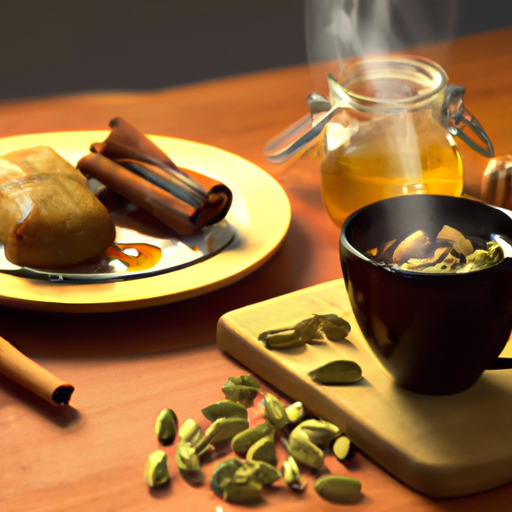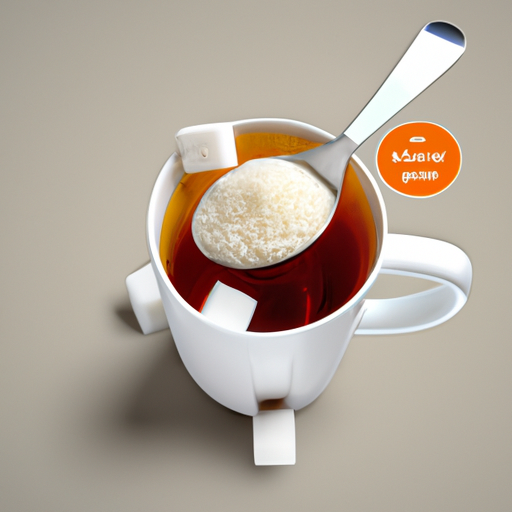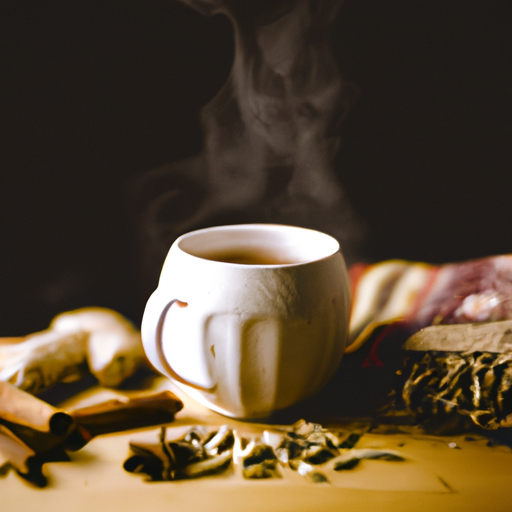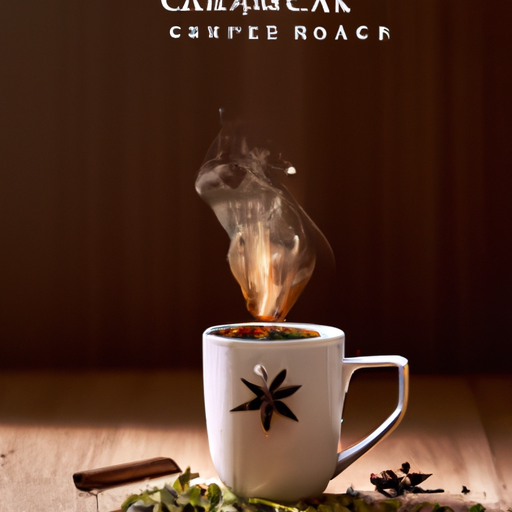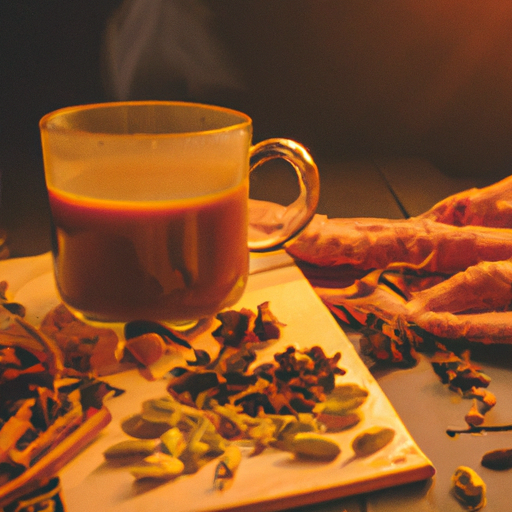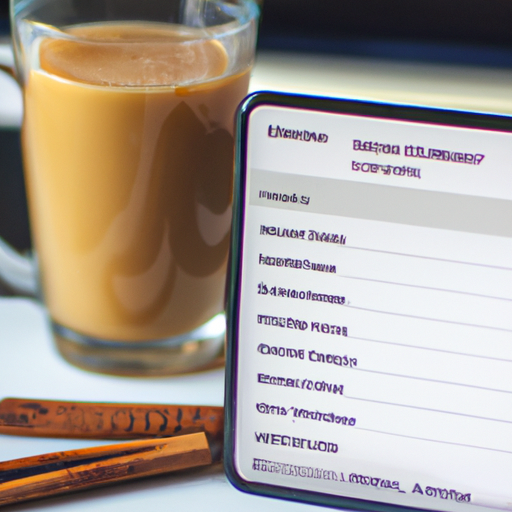Hello! As a huge enthusiast of chai tea, I’m thrilled to bring you all the information you need regarding Starbucks’ chai tea.
If you’re not familiar with this delicious beverage, chai tea is a spiced tea that originated in India and has been enjoyed for centuries. It’s made by steeping black tea leaves with a blend of aromatic spices such as cinnamon, cardamom, ginger, cloves, and black pepper.
At Starbucks, they offer several varieties of chai tea that can be customized to your liking. Whether you prefer it hot or iced, sweetened or unsweetened, there’s a chai tea option for everyone.
In this article, we’ll dive into the history of chai tea and its ingredients, as well as how it’s made at Starbucks. Plus, we’ll explore the health benefits of drinking chai tea and even provide some tips on how to make it yourself at home.
So let’s get started!
Key Takeaways
- Chai tea is a spiced tea that originated in India and is made by steeping black tea leaves with a blend of aromatic spices such as cinnamon, cardamom, ginger, cloves, and black pepper.
- Starbucks uses a mix of Indian spices to give its chai tea that traditional taste and aroma that customers have come to love, with main ingredients including black tea, cinnamon, ginger, cardamom, and clove.
- Chai tea comes in a variety of popular flavors at Starbucks, including seasonal flavors like pumpkin spice and gingerbread.
- Chai tea is loaded with antioxidants that fight harmful free radicals and reduce inflammation throughout the body, aids digestion, and can even aid in weight loss by boosting metabolism and increasing fat burning.
A Brief History of Chai Tea
Get ready to feel cultured and refined because we’re diving into the fascinating history of chai tea!
Chai tea’s cultural significance dates back centuries ago, originating from India where it was known as ‘masala chai.’ In Hindi, masala means a mixture of spices, and chai means tea. The blend was made with black tea leaves, milk, sugar, and a combination of spices such as cardamom, ginger, cinnamon, cloves, and pepper.
Over time, chai tea spread throughout the world and underwent variations in different cultures. In Western countries like the United States, some blends include flavors like vanilla or pumpkin spice. In Thailand, they use condensed milk instead of regular milk for a sweeter taste. Each country has its own take on this beloved beverage that reflects their unique culture.
Now let’s explore the ingredients that make up a classic chai tea blend without skipping a beat.
The Ingredients of Chai Tea
I love chai tea – it’s a comforting and delicious beverage that always hits the spot.
But have you ever wondered what actually goes into making this beloved drink?
Well, there are a few key ingredients: black tea, aromatic spices (like cinnamon, cardamom, and ginger), and milk and sweeteners to balance out the strong flavors.
These components come together in perfect harmony to create a warm and cozy drink that’s perfect for any time of day.
Black tea
You’ll love the robust flavor of Starbucks’ black tea chai, which blends spicy ginger, sweet cinnamon, and black tea for a perfect pick-me-up. Black tea is known to offer numerous health benefits such as boosting heart health, improving digestion, and reducing stress levels.
There are different types of black tea blends available in the market with unique flavors and aroma. The bold taste of black tea pairs well with aromatic spices like ginger and cinnamon, creating an enticing blend that is sure to awaken your senses.
The combination of these ingredients makes for a deliciously warm and comforting beverage that can be enjoyed any time of day.
Aromatic spices
Indulge in the irresistible aroma of aromatic spices that add a burst of flavor to your favorite black tea blends. Spices like cinnamon, cardamom, cloves, ginger, and black pepper are commonly used in chai tea, giving it a unique and bold taste that is both spicy and sweet. These spices not only enhance the flavor of the tea but also offer numerous health benefits.
Cinnamon has anti-inflammatory properties that can help reduce inflammation in the body. Cardamom aids digestion and can alleviate symptoms of indigestion such as bloating and gas. Cloves have antimicrobial properties that can fight off bacteria and viruses. Ginger has anti-nausea effects and can relieve nausea caused by motion sickness or morning sickness during pregnancy. Black pepper contains piperine which enhances nutrient absorption in the body.
Transitioning into the subsequent section about milk and sweeteners, adding these ingredients to your chai tea can really elevate its taste profile while providing added health benefits as well!
Milk and sweeteners
One popular way to enjoy aromatic spices is by adding milk and sweeteners to black tea blends. For example, in India, it’s common to mix chai masala with milk and sugar for a rich and creamy beverage. When it comes to the types of milk used in making chai, whole milk is the most traditional option because of its richness. However, non-dairy alternatives such as almond milk, soy milk, or coconut milk can be used as well.
In terms of sweeteners for chai, granulated sugar is commonly used, but other options like honey or agave can also be added for a different flavor profile. It’s important to note that adding too much sweetener can overpower the taste of the aromatic spices in the blend.
With these elements combined, one can create a delicious and soothing cup of chai tea. Speaking of which, let me tell you about how Starbucks makes their version of this beloved drink!
The Making of Chai Tea at Starbucks
So, when it comes to making chai tea at Starbucks, there are a few key factors to consider.
First and foremost, the ingredients used play a crucial role in achieving that classic chai flavor. From black tea leaves to spices like cinnamon and cardamom, each element must be chosen carefully.
Next up is the preparation process how exactly does one go about brewing the perfect cup of chai? With a combination of steeping and simmering, along with some careful attention to timing and temperature, the end result can be a deliciously smooth and aromatic beverage.
Ingredients used
Take a sip of the warm, spiced chai tea latte made with black tea, cinnamon, ginger, cardamom and clove mixed with steamed milk for a comforting treat. At Starbucks, we use only the finest ingredients to create our signature blend of chai tea. Our classic recipe uses a mix of Indian spices to give it that traditional taste and aroma that customers have come to love.
To give you an idea of what goes into making our delicious chai tea latte, here is a table showing the main ingredients used in our recipe:
| Ingredient | Purpose |
|---|---|
| Black Tea | Base flavor |
| Cinnamon | Sweetness and spice |
| Ginger | Warmth and depth |
| Cardamom | Floral notes |
| Clove | Spiciness |
Our baristas expertly combine these ingredients with steamed milk to create the perfect balance of flavors in every cup. With its numerous health benefits and variety of options including iced or hot, sweetened or unsweetened, there’s no wonder why chai tea remains one of our most popular drinks.
Next up, let me walk you through the preparation process step-by-step so you can see just how much care goes into each cup of chai tea at Starbucks.
Preparation process
Let’s dive into how our expert baristas transform a blend of Indian spices and black tea into a comforting and aromatic beverage that warms the soul. Our chai tea brewing techniques involve steeping a mixture of black tea, cinnamon, cardamom, ginger, cloves, and black pepper in hot water for several minutes. The resulting infusion is then combined with steamed milk and sweetened with either honey or sugar to create the iconic chai latte.
When it comes to serving suggestions for chai tea, we recommend enjoying it hot or iced depending on your preference. For those who enjoy their drinks sweeter, adding whipped cream or caramel syrup can elevate the taste even further. Additionally, you may try pairing your chai latte with pastries such as scones or muffins for a cozy treat any time of day.
As we move onto discussing the popular varieties of chai tea Starbucks offers, you’ll discover just how diverse this beloved drink can be.
The Popular Varieties of Chai Tea Starbucks
One of the most beloved drinks at Starbucks is their chai tea, which comes in a variety of popular flavors. The classic chai tea latte is made with black tea, spices like cinnamon and cardamom, steamed milk, and a sweetener. It’s creamy and comforting, perfect for sipping on a chilly day.
Starbucks also offers seasonal chai flavors that are equally delicious. In the fall, you can try the pumpkin spice chai latte, which adds pumpkin flavor to the classic chai blend. During the winter holidays, there’s a gingerbread chai latte that combines gingerbread syrup with the traditional spices. And in the springtime, you can enjoy a vanilla bean coconut milk latte with added chai syrup for a refreshing twist.
Chai tea isn’t just tasty – it also has many health benefits. The spices in chai have anti-inflammatory properties and can aid digestion. Black tea contains caffeine for an energy boost and antioxidants to protect against cell damage.
So next time you’re looking for something warm and comforting to drink at Starbucks, consider trying one of their delicious varieties of chai tea!
Health Benefits of Chai Tea
I absolutely love drinking chai tea, not only for its delicious taste but also for the numerous health benefits it provides. Chai tea is loaded with antioxidants, which help fight off harmful free radicals that can damage our cells.
It’s also a great digestive aid as it contains ginger and cinnamon, both known for their ability to soothe upset stomachs and promote healthy digestion.
Lastly, chai tea has anti-inflammatory properties that can reduce inflammation throughout the body, making it a great choice for those suffering from joint pain or other inflammatory conditions.
Antioxidants
Antioxidants abound in Starbucks’ chai tea, providing a delicious and healthy beverage option. Here are four benefits of antioxidants in chai tea that you may not have known about:
- They protect your cells from damage caused by free radicals.
- Antioxidants can reduce inflammation in the body, which is linked to many chronic diseases.
- They help improve brain function and may even lower the risk of cognitive decline as we age.
- Some studies suggest that antioxidants can also boost immune function and decrease the risk of infections.
Chai tea is a great way to reap these benefits while enjoying a warm and comforting drink. But it’s not just about the antioxidants – there are many other health benefits associated with this popular beverage. In fact, chai tea has been used for centuries as a natural remedy for digestive issues due to its blend of spices like ginger and cinnamon, which we’ll explore in more detail in the next section.
Digestive aid
The blend of spices in chai tea can aid digestion and has been used as a natural remedy for centuries. The combination of ginger, cinnamon, cardamom, and cloves in chai tea can help to soothe the stomach and reduce bloating. Ginger is particularly effective at relieving nausea and improving digestion, while cinnamon can help to regulate blood sugar levels.
In addition to its digestive benefits, chai tea may also aid in weight loss. The spices in chai tea have been shown to boost metabolism and increase fat burning, making it a great alternative to sugary drinks like soda or juice.
Overall, the benefits of chai tea extend beyond just its delicious taste. It can also be a powerful tool for improving your overall health.
Speaking of which, let’s now take a closer look at the anti-inflammatory properties of this amazing beverage.
Anti-inflammatory properties
With its unique blend of spices, sipping on a warm mug of chai can help reduce inflammation in the body. Chai tea benefits include anti-inflammatory properties due to the presence of ginger, cinnamon, and cloves. These spices have been shown to possess anti-inflammatory properties that may help alleviate symptoms associated with conditions like arthritis and asthma.
Brewing techniques also play a role in maximizing the anti-inflammatory benefits of chai tea. Steeping chai tea for at least five minutes allows for maximum extraction of these beneficial compounds from the spices. Additionally, flavor profiles can vary based on the specific spices used and how they are proportioned in the blend.
Combining black tea leaves with a mix of whole spices like cinnamon sticks, cardamom pods, and fresh ginger root creates a fragrant and warming cup of chai that is both delicious and nourishing.
When it comes to making your own cup of chai at home, there are many different methods to choose from.
How to Make Chai Tea at Home
I absolutely love making chai tea at home! There’s nothing quite like the aroma of warm spices and black tea filling my kitchen.
In this discussion, I’ll share my recipe for homemade chai tea and give you some tips for making the perfect cup every time.
Recipe for homemade chai tea
To make homemade chai tea, it’s like putting together a puzzle with all the warm spices blending together perfectly. Chai tea is a popular beverage that holds cultural significance in India and other parts of the world. It’s typically made by brewing black tea with a mixture of aromatic Indian spices like cinnamon, ginger, cardamom, and cloves.
Here’s a simple recipe for making homemade chai tea:
| Ingredients | Instructions |
|---|---|
| 4 cups water | Add water to a pot and bring to boil |
| 6-8 black tea bags or loose leaf tea | Add the tea bags/leaves to the boiling water and let steep for 5 minutes |
| 1 cinnamon stick | Add the cinnamon stick to the pot |
| 1-inch piece of fresh ginger root, peeled and chopped | Add the chopped ginger to the pot |
| 4-6 whole cloves | Add cloves to the pot |
| 4-6 whole green cardamom pods | Crush cardamom pods lightly before adding them to the pot |
| 2 cups milk (optional) | Add milk if desired |
Once you have all your ingredients in place, simmer for an additional 10 minutes on low heat. Strain out any large pieces using a fine mesh strainer or cheesecloth. Serve hot with honey or sugar for sweetness.
For those who want to experiment with homemade chai tea variations, try adding different herbs and spices such as nutmeg, fennel seeds or star anise for added depth of flavor. With these tips in mind, you’ll be able to create your own perfect cup of chai in no time!
Tips for making the perfect cup
Achieving the perfect cup of homemade chai requires attention to detail and a few key tips. First, it’s important to experiment with different brewing methods to find what works best for you. Some people prefer steeping their tea in milk, while others prefer water. Try both and see which one brings out the flavors you like best.
Secondly, don’t be afraid to play around with flavor variations. Chai tea can be made with a variety of spices, including cinnamon, cardamom, ginger, and cloves. Experiment with different combinations until you find the perfect balance that suits your taste buds.
Another tip is to use fresh ingredients whenever possible, as this will greatly enhance the overall flavor of your chai tea. And finally, make sure to take your time when preparing your homemade chai tea – rushing through the process can result in a less-than-perfect cup.
When it comes to enjoying chai tea, there are many other ways besides simply drinking it hot or cold. Stay tuned for some creative ideas on how to incorporate this delicious beverage into your daily routine!
Other Ways to Enjoy Chai Tea
There are many delicious ways to savor the unique flavor of chai tea beyond just drinking it hot or iced from Starbucks. One way to spice up your chai tea is by adding a splash of milk and a drizzle of honey. This simple addition enhances the creaminess and sweetness of the drink, making it even more enjoyable.
Another great way to enjoy chai tea is by pairing it with food. Chai tea pairs well with spicy dishes like Indian curries, as well as sweet treats like cookies and cakes. The spices in chai complement the flavors in these foods, creating a harmonious taste experience.
As you explore new ways to enjoy your chai tea, keep in mind that this popular beverage has been enjoyed around the world for centuries. In the next section, we’ll take a closer look at some of the different cultural variations of this beloved drink.
Chai Tea Around the World
I hope you enjoyed learning about some alternative ways to enjoy chai tea. However, did you know that chai tea has cultural significance in many parts of the world?
In India, for example, it’s a staple beverage and is often served during special occasions like weddings or religious ceremonies. In fact, there’s even a traditional chai tea ceremony that involves boiling loose-leaf black tea with spices like cinnamon, cardamom, and ginger before adding milk and sugar.
But India isn’t the only country where chai tea holds cultural importance. In Morocco, it’s common to serve mint-infused green tea with a variety of sweet treats as a sign of hospitality. And in Turkey, they have their own version called ‘çay'(pronounced ‘chai’) that’s brewed using black tea leaves and served in small tulip-shaped glasses.
Learning about the cultural significance of chai tea makes me appreciate it even more. It’s fascinating how one beverage can hold so much meaning and be enjoyed in different ways all around the world.
Speaking of enjoyment, now that we know more about chai tea globally, let’s explore where to find the best cups of this delicious drink!
Where to Find the Best Chai Tea
If you’re looking to indulge in a cup of this spicy and aromatic beverage, you’ll be pleased to know that there are plenty of places around the world where you can find the best chai tea.
In my opinion, some of the best chai tea brands include Teavana, Big Train, and Oregon Chai. These brands offer high-quality ingredients and unique blends that make for a delicious cup of chai.
For those who prefer making their own chai tea at home, there are plenty of recipes available online. Some popular ones for summer include iced chai latte with coconut milk or almond milk and spicy mango chai smoothie. These recipes allow you to customize your chai tea exactly how you like it and experiment with different ingredients.
In addition to specialty coffee shops and online retailers, many Indian restaurants also serve authentic Masala Chai. This type of chai is brewed with black tea leaves, spices such as ginger and cinnamon, milk, and sugar. It’s a classic recipe that has been enjoyed for centuries in India and now all over the world.
So whether you’re looking for a pre-made brand or want to try your hand at making your own, there are plenty of options out there for finding the best chai tea around.
Frequently Asked Questions
What is the difference between chai tea and regular tea?
Comparing chai tea to regular tea is like comparing apples to oranges. While both are made from the same plant, the Camellia sinensis, they differ greatly in taste and composition.
Chai tea is a spiced tea blend that typically includes black tea, ginger, cardamom, cinnamon, cloves, and black pepper. This combination of spices adds complexity and depth to the flavor profile of the tea.
Regular tea, on the other hand, is simply steeped leaves from the Camellia sinensis plant without any added spices.
Aside from taste differences, chai tea also offers unique health benefits due to its spice blend. Ginger has anti-inflammatory properties that can help reduce pain and swelling in the body. Cardamom has been shown to improve digestion and relieve nausea. Cinnamon may help regulate blood sugar levels and reduce inflammation as well.
In conclusion, while both chai tea and regular tea come from the same plant family, they are vastly different in taste and composition. Chai’s spiced blend adds complexity while offering potential health benefits through its use of ginger, cardamom, cinnamon among others.
Is chai tea vegan?
As a vegan, I’m always looking for plant-based chai options.
Chai tea is typically made with black tea and a blend of spices such as cinnamon, ginger, cardamom, and cloves. While these ingredients are vegan-friendly, ethical concerns arise with the production of some chai teas.
Some companies use milk powder or honey in their blends, which aren’t suitable for a vegan diet. It’s important to check the ingredients list before purchasing chai tea to ensure it aligns with your values.
Additionally, some brands source their tea leaves from unethical farms that exploit workers or harm the environment. It’s crucial to research and choose brands that prioritize fair trade and sustainable practices in their production processes.
How much caffeine is in chai tea?
How much caffeine is in chai tea? Well, it depends on the type of chai tea you’re drinking.
Traditional Indian chai tea made with black tea usually contains about 50mg of caffeine per cup, while herbal chai teas made with rooibos or other herbs are naturally caffeine-free.
But beyond just the caffeine content, there are many benefits to drinking chai tea. The blend of spices like cinnamon and ginger can aid in digestion and boost immunity. Plus, the warmth and comfort of a cozy cup of chai makes it a perfect beverage for any time of day – whether you need a morning pick-me-up or a soothing evening drink before bed.
So really, the question isn’t just how much caffeine is in your chai tea, but what are all the amazing benefits and when is the best time to enjoy it?
Can you customize your chai tea order at Starbucks?
Yes, you can definitely customize your chai tea order at Starbucks. They offer a variety of customization options and flavor variations to suit your taste preferences.
You can choose the type of milk you want, such as almond or soy milk, and add sweeteners like vanilla syrup or honey. Additionally, you can ask for extra foam or spice if you prefer a stronger flavor profile.
Overall, Starbucks is known for its flexibility when it comes to customizing orders, so don’t be afraid to ask for exactly what you want in your chai tea.
Are there any negative side effects of drinking chai tea?
I must admit that I love drinking chai tea, but as with any drink or food, there could be some negative side effects for some people.
However, one of the most common benefits that people associate with chai tea is its digestive properties, thanks to the various spices and herbs that it contains, such as ginger, cinnamon, cardamom, and clove. These ingredients have been used in traditional medicine for centuries to soothe upset stomachs and promote better digestion. Of course, this doesn’t mean that everyone will experience these benefits equally or at all.
On the other hand, some people may have allergic reactions to certain components of chai tea or the way it’s prepared. For example, if you’re sensitive to caffeine or dairy products (which are often added to chai lattes), you might experience jitters or indigestion after drinking a cup of chai tea from Starbucks or elsewhere. Additionally, some brands of chai tea may contain artificial flavors or sweeteners that could trigger negative reactions in certain individuals.
As always, it’s important to listen to your body and consult with a healthcare professional if you have any concerns about your health and well-being.
Conclusion
In conclusion, chai tea at Starbucks is a heavenly experience that’ll awaken your senses and leave you wanting more.
The combination of spices and sweetness creates a unique flavor profile that’s unmatched by any other drink. Whether you prefer the classic chai latte or want to explore the various variations, there’s always something new to discover.
And if you think that chai tea is only for drinking, think again! You can use it in recipes such as baked goods or even add it to your morning smoothie for an extra kick.
With its numerous health benefits and versatility, chai tea truly proves itself as a beverage fit for royalty. So next time you’re at Starbucks or making it at home, be sure to savor every sip and indulge in the magic of chai tea.

